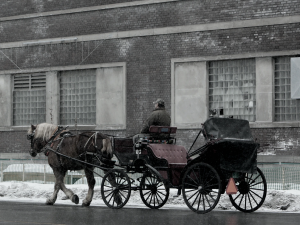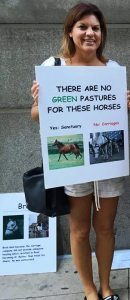How a Small Group of Grassroots Activists Helped Secure Chicago’s Ban on Horse-Drawn Carriages
By Mark Hawthorne
Beginning January 1, 2021, the streets of Chicago are going to look a little more animal-friendly. Gone will be the horse-drawn carriage operators who have been plying their cruel trade in the Windy City for 150 years. On April 24, the Chicago City Council voted to ban them. Chicago joins other cities in banning horse-drawn carriages, including Las Vegas and Reno, Nevada; Salt Lake City, Utah; Santa Fe, New Mexico; Biloxi, Mississippi; Camden, New Jersey; and several cities in Florida. (Despite years of protesting, horse-drawn carriages still operate in New York City.) streets of Chicago are going to look a little more animal-friendly. Gone will be the horse-drawn carriage operators who have been plying their cruel trade in the Windy City for 150 years. On April 24, the Chicago City Council voted to ban them. Chicago joins other cities in banning horse-drawn carriages, including Las Vegas and Reno, Nevada; Salt Lake City, Utah; Santa Fe, New Mexico; Biloxi, Mississippi; Camden, New Jersey; and several cities in Florida. (Despite years of protesting, horse-drawn carriages still operate in New York City.)
Instrumental in getting the ban passed was the Chicago Alliance for Animals (CAA). For more than three years, this grassroots animal advocacy organization frequently documented horses being denied water and forced to pull carriages in heavy traffic through extreme heat, thunderstorms, and blizzards. They lobbied lawmakers to support the ban, and now that the ban has passed, they are liaising with reputable sanctuaries to arrange homes for the horses—if their owners choose to allow them the safe and peaceful retirement they deserve.
Jodie Wiederkehr, CAA’s executive director and founder of the Partnership to Ban Horse Carriages Worldwide, took some time to answer my questions about her work and the group’s remarkable campaign.
What inspired you to become an animal activist?
I’ve cared deeply about animals since I was very young. I remember at around the age of nine or 10, my father was yelling for me to come inside on Christmas Eve. I was sitting outside in the snow next to the kennel of our neighbor’s little terrier dog, who had nothing but a barren dog house and frozen water. I would bring him treats and fresh water.
While inside in our cozy finished basement with a roaring fire, we ate a big dinner and a lot of cookies and candy and then opened presents. All the while, I thought about Cinnamon all alone in the cold.
That love of animals stayed with me all through my childhood and through college when I started volunteering with my sister Jamie to ban the steel-jaw leghold trap in Illinois.
From then on, I’ve been working toward a path to liberate animals from suffering.
 There are so many ways people exploit animals. What is it about the horse-carriage industry that makes you want to see it banned? There are so many ways people exploit animals. What is it about the horse-carriage industry that makes you want to see it banned?
I care greatly about all animal issues, but whenever I see horses where every part of their being is controlled with straps and clasps and they’ve got all this metal junk in their mouth and when they can’t get flies off their legs, I get so incredibly sad. It’s just pure exploitation, and it’s so unnecessary!
And this whole notion that they were bred to do this work or that because they’ve been doing it since the dawn of time somehow makes it okay is a lousy excuse, as we all know that “tradition” does not equal “right.”
Can you walk us through the important steps you and CAA took to help get this ban passed?
We used a variety of methods, but the most important aspect of our work was to educate ourselves on Chicago’s laws regarding the horse-carriage trade, document the multiple violations on a regular basis, and then send that documentation to the agency tasked with monitoring and enforcing the laws as well as to the aldermen and mayor. We then submitted Freedom of Information Act requests for the results of our documentation and sent press releases to the media.
We also took action every day with our Daily Action Alerts—DAAs for short—where we contacted all the aldermen, the mayor, and tourist outlets in Chicago and informed them of the constant animal welfare violations, as well as those that impacted public safety.
We attended Aldermen’s Ward nights; testified at City Council almost every month for nearly two years; had monthly, peaceful educational outreach down by the carriage stand, where we held signs and a banner; asked people to sign our petition; urged everyone we spoke to to contact their alderman or, if they lived outside of Chicago, to please contact the mayor.
We also asked any businesses, legislators, animal advocacy organizations, celebrities, etc., to sign our Endorsement Pledge. In the end, we had more than 200 Endorsement Pledges representing millions of people who wanted a horse carriage ban in Chicago.
In addition, we fundraised last fall to deck out a pedicab urging people to say no to inhumane horse carriage rides.
What was the general reaction of the public when you were doing outreach?
When we first started our peaceful educational outreach in summer 2015, we would occasionally get some pushback and people claiming that horse carriages are not inhumane and that the horses are treated well, but as the years went on and we continued to educate the public on how often the horses were overworked, under-watered, and worked in extreme temperatures, the arguments nearly ceased. At times, we had groups of 10 or more people standing around us waiting to sign our petition.
Did you get any comments from horse-carriage operators during your campaign?
We never spoke to or communicated with the carriage operators or passengers. Our goal was to document the violations and abject cruelty and educate the public, not engage with those who have no empathy for and who profit off the voiceless.
You also worked on a successful campaign to ban greyhound racing in Massachusetts, which went into effect in 2010. Do you see any similarities in these two campaigns?
Yes, definitely! With both campaigns, we exposed the animal exploiters’ constant flouting of the law. And as the statewide volunteer coordinator on the greyhound campaign, I was responsible for calling my volunteer coordinators each Monday and asking them if they called their volunteers. It was not easy, as many didn’t want to talk to me. That made me realize if we really want a more humane world, we must be willing to give a little of our time to this very important cause. So now, when I put out my DAAs, I expect people to take action, and I explain to my volunteers that complaining about animal abuse and sad emojis will not ban horse carriages or help animals in any way.
 How can people support the Chicago Alliance for Animals? How can people support the Chicago Alliance for Animals?
Please join our Facebook page and take one minute to do our DAAs. Follow us on social media, and if they are able to financially support us in any way—even $1 a month will help—that would be greatly appreciated! We passed this ban in the third-largest city in the U.S., without a horse collapsing in the street or a serious or deadly accident, in less than three years without any paid staff.
What advice do you give to activists who want to help ban the exploitation of horses?
I would urge them to join the Partnership to Ban Horse Carriages Worldwide and the Chicago Alliance for Animals (CAA) on Facebook and Twitter (here and here, and here and here), participate in our daily actions and communicate with me and activists around the world on a regular basis so we can work together to ban this archaic relic worldwide.
And, most importantly, never give up!
To make a donation to CAA, click here.
Mark Hawthorne Bio:
 I am the author of three books on animal rights and social justice: Striking at the Roots: A Practical Guide to Animal Activism, a guide to empowering people to get active for animals around the world; Bleating Hearts: The Hidden World of Animal Suffering; and my latest, A Vegan Ethic: Embracing A Life Of Compassion Toward All. I stopped eating meat after an encounter with one of India’s many cows in 1992, then went vegan a decade later. Beginning in 2004, I served as a contributing writer for Satya until the magazine ceased publication in 2007, and am a frequent contributor to VegNews magazine. My writing has also appeared in Vegan’s Daily Companion by Colleen Patrick-Goudreau (Quarry Books), Stories to Live By: Wisdom to Help You Make the Most of Every Day (Travelers’ Tales) and The Best Travel Writing 2005: True Stories from Around the World (Travelers’ Tales), as well as The Vegan, Laika, Vegan Voice, Herbivore, Hinduism Today, Utne.com and newspapers across the United States. His informative blog is Striking at the Roots: Animal activist around the world. Author photo by Tara Baxter. I am the author of three books on animal rights and social justice: Striking at the Roots: A Practical Guide to Animal Activism, a guide to empowering people to get active for animals around the world; Bleating Hearts: The Hidden World of Animal Suffering; and my latest, A Vegan Ethic: Embracing A Life Of Compassion Toward All. I stopped eating meat after an encounter with one of India’s many cows in 1992, then went vegan a decade later. Beginning in 2004, I served as a contributing writer for Satya until the magazine ceased publication in 2007, and am a frequent contributor to VegNews magazine. My writing has also appeared in Vegan’s Daily Companion by Colleen Patrick-Goudreau (Quarry Books), Stories to Live By: Wisdom to Help You Make the Most of Every Day (Travelers’ Tales) and The Best Travel Writing 2005: True Stories from Around the World (Travelers’ Tales), as well as The Vegan, Laika, Vegan Voice, Herbivore, Hinduism Today, Utne.com and newspapers across the United States. His informative blog is Striking at the Roots: Animal activist around the world. Author photo by Tara Baxter.
Back to Issue 3
|

